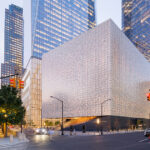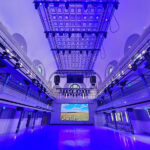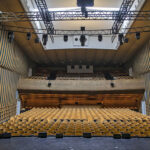
Year-Round “NFL Experience” Scores Points with Football Fans
Part themed attraction, part museum exhibit, “The NFL Experience,” located in New York City’s Times Square, is a new permanent interactive football experience for both the die-hard and casual fans of the game. The NFL, working with the Cirque du Soleil Entertainment Group, have created a multi-floor experience where visitors come in as if they were a new player in the league. They get to see and experience the different teams through interactive displays of videos, audio clips, and historical artifacts including a Lombardi Super Bowl trophy, all of the Super Bowl tickets, and a collection of the winning team’s rings over the years. There’s also a 4D Stadium theater experience of what it’s like to be on the playing field from the player’s perspective from pre-season through the Super Bowl and in various kinds of weather.
This themed experience was designed by Cirque in partnership with experience design company Thinkwell Group, who specialize in themed entertainment. Thinkwell provided a wide range of creative, design, and production services to bring the NFL Experience (NFLX) to life, including technical, lighting, and audio design, in-field art direction, and installation and construction oversight. The Stadium 4D experience was produced and delivered by Montreal-based 4U2C, a video and technical design company, that’s part of Cirque du Soleil, with equipment and technical solutions provided by Solotech.

The Playbook
“Cirque du Soleil approached us with a unique challenge,” says François Bergeron, chief operating officer of Thinkwell. “How could we turn this space into an interactive NFL exhibit — better yet, into an engaging fan experience? We realized we could use the same technology and design principles that help us design and produce museums and theme parks to turn the NFL itself into an attraction — with eight engaging experiences backed by augmented reality and other cutting-edge, interactive technologies.”
There is a well-planned flow to the narrative of the NFLX, as Bergeron explains, “Basically, you go in the theater and you get what the NFL is from the player point of view — the impacts and all of that. It is an immersive environment. Then, after that, you go into the direct interactive activities. You train to become a player. You suit up, and the coach tells you the plays that he wants to run. You huddle-up, call the play, and then you throw the ball. Now you’re a player. You win the Super Bowl, and you celebrate. That’s the whole idea.
“I think that the creative teams did an amazing job at finding the storyline, following it, and making sure that every element is connected to that idea,” Bergeron continues. “It’s cohesive — each attraction increases the understanding of the narrative. Nothing is out of place; everything moves in the same direction of the narrative.”
The Cirque and Thinkwell teams worked to balance the wealth of NFL archival materials with interactive areas for the visitors, and to ensure that the technologies chosen would be reliable for the long term for this year-round attraction, which is generally open for a constant stream of visitors between eight and 10 hours every day. When asked what he would call out as a highlight of their work, Bergeron says “the judicious use of technology to support the narrative. We had to make a choice at some point to say, ‘Do we go really cutting edge?’ Well, ‘no,’ because this is a little more like a theme park where there’s a lot of throughput. We had to choose technology that was proven. Maybe repackage it in a different way; push the algorithms, the CG, and all that to a certain extent to push the envelope. We really took the story and picked the technology that matched the story.”

Bone-Rattling Hits
The Stadium Theater is where you first feel like you’re a player on the field. And when they say feel it — they mean it. The system designers used 180 D-Box cinematic motion seats that consist of specialized hardware and software that moves visitors to what’s going onscreen; hits and shakes whenever players in the video get hit. It immerses visitors into the video; you literally feel a part of the football game.
Like the path you take with the rest of the exhibits — preseason rookie through to the Super Bowl — the 10-minute show in the 4D theater takes guests on the same arc. You start out, playing in the hot sun of a preseason game through rainy fall games to snowy cold games in December — and everything in-between. Visitors experience wind, snow, and the aromas of the stadium.
The entire technical system in the theater — video projection, media servers, audio, and lighting — was all overseen by 4U2C with a system design by Robert Levac, who — along with show producer Timothy Durant of 4U2C — walked PLSN through their video projection system. They worked closely with the systems integration team from Solotech, led by Solotech’s project manager, Chris Washkau, and vice president of international project development, Bob Barbagallo. “We have worked quite a bit with Cirque; 4U2C, and Levac,” notes Barbagallo. “But this job was a unique because it was a one-button push to trigger the entire show system. It was challenging, but rewarding in the results.”
When asked about the systems integration team on this project, Levac credits Solotech for “a great job — the install quality was very good, and they put in the extra hours and effort whenever needed to get the project done; especially Chris.” Noting that “this was a very unique show with no operators, we needed to make a lot of adjustments to the automation system and the user interfaces.”
The 180-seat theater contains a custom-built wrap-around front-projection environment that is approximately 154-by-30-by-25 feet (WxDxH). The video system uses 12 Barco F90-4K13 4K DLP laser phosphor projectors, with an image resolution of 9,696 by 3,224 pixels — three times the size of a 4K image. Video imagery is projected on the front wall, the two angled side walls and the ceiling of the space, creating an immersive feel.
There were a lot of challenges for the theater team, including the shape of the room, which reflected the building’s unique architecture. “It’s a very small room, with a lot of tight, oblique angles and a shallow depth of field because of the short throw,” explains Durant. Although “the angle of the walls helps create more of an immersive spatial feel,” the “multiple angles made it more of a challenge. But we made it work.”

Under the Hood
Levac agrees. “It’s a strange shape. The theater has some challenges in terms of the geometry of it, so we had to use short throw lenses for the side and front projectors. One of the things with the system that I wasn’t crazy about was the rigging — we were forced to put the projectors in the house. That’s when we looked at the laser phosphor projectors, because they are much, much quieter. We tried a bunch of different ones and we landed on these Barco F90 units. They’re super-quiet and perform well; they’re about 37 or 38 dB. I mean, it’s amazing how quiet they are here. We’re pretty happy with that solution.”
The media servers for the NFLX are from VYV out of Montreal. “I don’t know how many people know about VYV, but they build servers that are similar to Hippotizer, coolux or d3 [disguise],” comments Levac. “They have redundancy built into their products, so we’ve got a separate output to each projector, and we have a spare VYV media server. There are three media servers with four outputs active. Each server has its own color correction, geometry correction and edge blending. Then there’s a fourth server with four outputs that can automatically take over for any of the other three in the event of a failure.”
The VYV media servers also trigger the snow and wind effects, plus the aroma effects in the theater. As the video plays its timeline, it’s also sending E-DMX and Art-Net to the different special effects, and are all synchronized with the timecode.
As a part of his systems design spec, Levac chose to go with three servers, which split up and balance the work. “Basically, we wanted a separate output to each projector so that we could control the geometry corrections; so, we can do convergence and all the alignment as accurately as possible,” he says. “The 3D model of the entire theater is in each of the media servers with all of the corrections applied that one 3D model and is shared by all. Also, we wanted a separate feed to each projector so that everything — the signal from front to back — is all native resolution and front to back we’ve actually got two feeds to each projector in each position.”
The system is constantly checking the inputs and outputs of the matrix switches. If there is a loss of output, or input, to the media server or projector, the system will automatically switch to a backup server and tells it which server it now is in the system. “It tells the Lightware matrix switch to reroute all of the outputs to the projectors,” explains Levac. “When it switches, it’s quite quick. If we’re switching from the backup to media server two or three, which are the two servers that are doing the least amount of work, it’s seamless; you barely see it. If we’re switching from the main one, which is doing all the timeline, you might see a little bit of a flicker in color, and then that’s it. I was pretty impressed with how well it works.”
The system redundancy is robust. Each projector position, for example, is doubled up, with two 12K projectors in each spot. If half were to stop working, the technicians might know about it, but the system would keep running without a noticeable disruption, and the technical team could address the issue afterwards.

A Deep Bench of Redundancy
Normally, Levac designs systems for productions where there’re full departments of technicians for each discipline. Here, the system had to be automated to one-button press. “Usually, at the end of a design, I hand off the entire system to a complete production crew, which has technicians and programmers and guys that know the gear better than I do,” he says. “In this case, it’s an automated system, so the design is a bit different, so there’s a lot of redundancy built in. The system basically runs 365 days a year and about 12 hours a day. It’s run by a docent who basically pushes ‘Play,” and that’s it.”
The team created an integrated system with overall control provided by a Crestron control system. Once the guests have all been seated in the theater the docent hits a single play button and it’s all automated with redundancy built-in. The only thing the docent needs to do is stop the show with an E-stop in case of emergency.
“The Crestron system is controlling the VYV media servers for media playback of the video plus all of the cues, like the special effects — aromas, the wind, and snow,” explains Durant. “We use JoeCo for the timecode and audio, and it’s tied into the D-Box system for the seats. The motion of the seats was designed by D-Box themselves.”
There is redundancy in terms of projector control as well. “There’s standard Ethernet and RS-232 feeding to each projector, so if we lose one, you can still control the projectors with the second protocol,” says Levac. “There are two sets of downlinks to all the switches on the projectors, so if you lose a downlink, it automatically switches from fiber to Cat-6.

“The redundancy is the thing that I’m happiest with overall, and the fact that the system really is quite complex in the background, yet it’s run from a single button press,” notes Levac. “We did a couple of tests. I pulled the power on the JoeCo audio unit, pulled the power on the media server — quite a bit of those things — and the system just kept going. If you were in the audience you probably would barely notice it, if at all.

“I’ve designed a lot of systems over the years, and this one is unique. It’s got so much redundancy, and the duty cycle on it is so high. It’s running constantly and run by somebody who knows nothing technically about it. To ensure the run of the show was rock-solid and stable, Solotech brought in one of their top programmers to sit with me and the 4U2C media server programmer. It has been running non-stop every day since November — up to 20 showings a day.”
The NFL Experience has been visited by many die-hard football fans, of course. But it has also proved captivating to a broader spectrum of visitors. “We needed to do something that people could not get on television, social media, or even VR at home,” says Bergeron. “We didn’t want people to put on goggles and be in their own universe. We want to have people experience something together. It’s also not a museum. It’s more a place where you experience the game. Even people that are not fans of football will find something that is interesting and fun. It’s physical, it’s interactive, and you don’t have to be an aficionado. You don’t have to be an expert in NFL to enjoy the NFL Experience in New York.”


